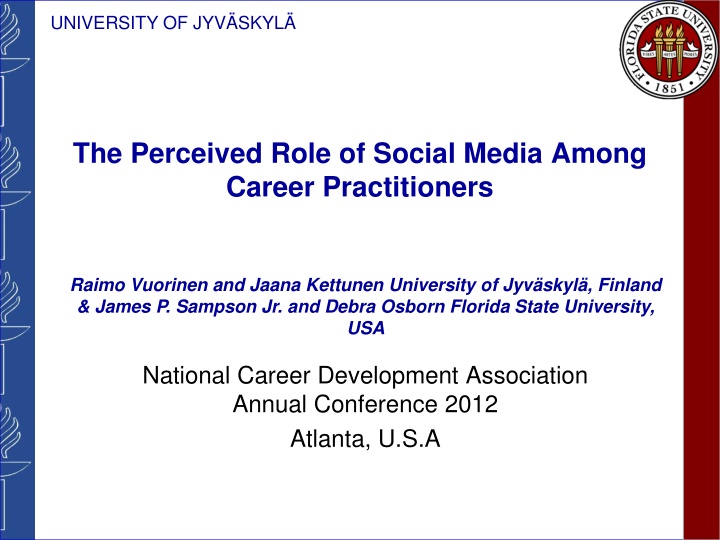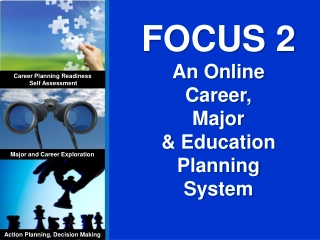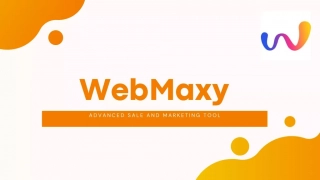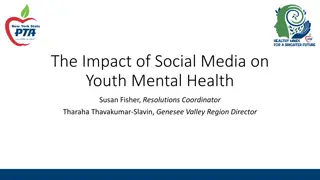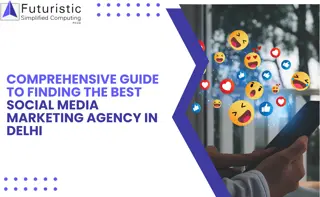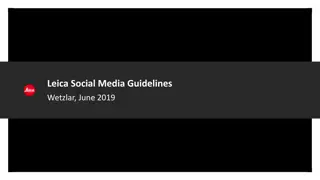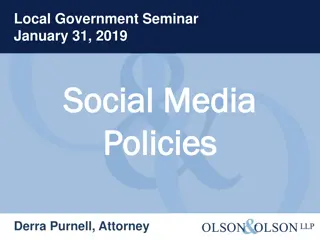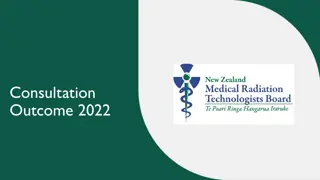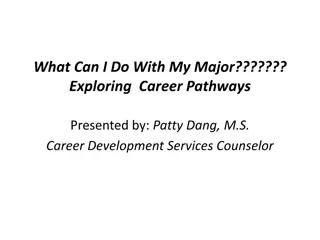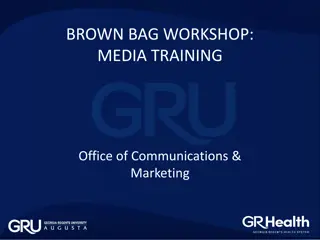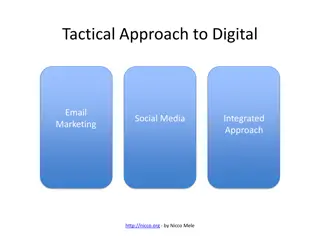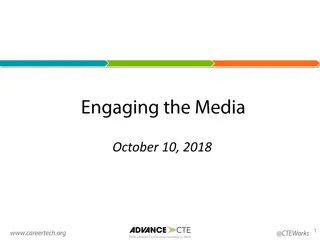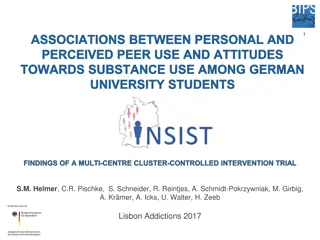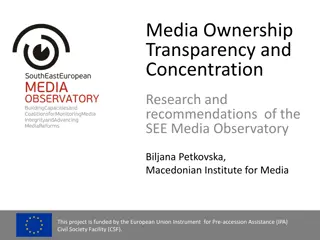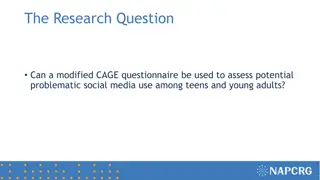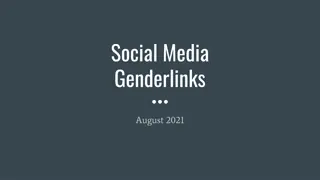Perceived Role of Social Media Among Career Practitioners
This study explores the use and impact of social media in career guidance services. It delves into previous research on the internet's role, material development, and automated interactions. The definition of social media and its form of communication are also discussed. The research aims to bridge the gap in understanding practitioners' views on leveraging social media for career development.
Uploaded on Apr 04, 2025 | 1 Views
Download Presentation

Please find below an Image/Link to download the presentation.
The content on the website is provided AS IS for your information and personal use only. It may not be sold, licensed, or shared on other websites without obtaining consent from the author.If you encounter any issues during the download, it is possible that the publisher has removed the file from their server.
You are allowed to download the files provided on this website for personal or commercial use, subject to the condition that they are used lawfully. All files are the property of their respective owners.
The content on the website is provided AS IS for your information and personal use only. It may not be sold, licensed, or shared on other websites without obtaining consent from the author.
E N D
Presentation Transcript
UNIVERSITY OF JYVSKYL The Perceived Role of Social Media Among Career Practitioners Raimo Vuorinen and Jaana Kettunen University of Jyv skyl , Finland & James P. Sampson Jr. and Debra OsbornFlorida State University, USA National Career Development Association Annual Conference 2012 Atlanta, U.S.A
UNIVERSITY OF JYVSKYL Finnish Institute for Educational Research (FIER) National Center for LLG expertise National task force: Targeted research for lifelong guidance practice and policy development Co-ordination of the European Lifelong Guidance Policy Network (ELGPN) 2007-2012 National and international conferences 1st European Lifelong Guidance Policy Conference 2006 IAEVG 2009
UNIVERSITY OF JYVSKYL Previous Research/ literature Internet in guidance Information source, Interaction among clients and guidance professionals (Bimrose & Barnes, 2010; Harris-Bowlsbey & Sampson, 2005; Offer & Chiru, 2005; Watts 2002; Sampson 2008; Vuorinen, 2006) Material development (Barnes, La Gro & Watts, 2010; Vuorinen 2006), automated interaction, games and simulations (Hooley, Hutchinson & Watts 2010). Facilitation and management the overwhelming amount of information. (Sampson, Shy, Offer & Dozier 2010).
UNIVERSITY OF JYVSKYL Previous Research/ literature Guidance in Internet Delivery of information, material development, automated interaction or a channel for communication (Hooley, Hutchinson & Watts 2010; Vuorinen 2006, Sampson 2008; Watts & Offer 2006). Applications with or without automated interaction. Generic counselling processes to help clients make effective use of ICT in career guidance (Sampson 2008). Careering through the web (Hooley, Hutchinson & Watts 2010). Gap: Due to the novelty of use of social media in career services there has been little research describing the conceptions of career practitioners
UNIVERSITY OF JYVSKYL Defining the social media Social media is a process, where individuals and groups build up a common understanding and meanings with contents, communities and web 2.0 techology. Content Social media Sources: Kangas et al. (2007) and Ahlqvist et al (2010) Community Web 2.0
UNIVERSITY OF JYVSKYL Defining the social media form of communication which makes use of information networks and information technology and deals with content created by users in an interactive way and in which interpersonal relationships are created and maintained Source: Finnish Terminology Center (2010)
UNIVERSITY OF JYVSKYL Aim of the study The main aim is to discover and describe the qualitatively different ways in which career practitioners conceptualize the target phenomenon The particular study questions were framed as follows: 1. What are the career practitioners conceptions of social media? 2. What are the critical aspects that differentiate between qualitatively varying ways of understanding the phenomenon?
UNIVERSITY OF JYVSKYL Method Phenomenographic research Investigates the qualitatively different ways in which people at collective level experience or conceptualize the target phenomenon (Marton and Booth, 1997; Marton and Pong, 2005; kerlind, 2005; 2012) The result is the identification of categories of description in which the different ways of conceiving the phenomenon are hierarchically and logically interrelated, and hence the establishment of a typology (Ashworth and Lucas, 1998).
UNIVERSITY OF JYVSKYL Data collected using focus group interview methodology 15 career practitioners (14 women, 1 man), who were experienced Internet users but novices on the social media practitioners represented Finnish guidance community from lifelong guidance perspective (comprehensive, secondary and higher education as well Public Employment Services) analyzed using phenomenographical data analysis methods
UNIVERSITY OF JYVSKYL Results Career practitioners conceptions of social media in career services CATEGORIES DIMENSIONS OF VARIATION unnecessary dispensable possibility desirable indispensable Attitude Setting Opportunities Perception Nature of interacton Guidance locus Guidance paradigm Role of practitioner
UNIVERSITY OF JYVSKYL Category 1: Social media in career services is unnecessary Guidance Locus supplier driven, time and space specific Attitude Perception Role of practitioner Negative; not relevant threat to the profession and to the practice expert role Opportunities Guidance Paradigm emphasizing the individual face to face career services Setting Nature of interaction The everyday setting for young peoples live not acknowledged practitioner to individual
UNIVERSITY OF JYVSKYL Category 2: Social media in career services is dispensable Attitude Perception Role of practitioner Guidance Locus sceptical; passing fad challenge, difficult to comprehend supplier driven, time specific advising role Guidance paradigm Setting Opportunities Nature of interaction The setting for creating and sustaining connections information delivery Individual guidance practitioner to individual
UNIVERSITY OF JYVSKYL Category 3: Social media in career services is apossibility Attitude Perception Guidance Locus Role of practitioner unsure; potentially useful means creates a need to change the accustomed ways to do work Opportunities supporting role demand driven, time specific Nature of interaction Guidance paradigm Setting The setting for discussions initiate Individual and group guidance practitioner with individual communication
UNIVERSITY OF JYVSKYL Category 4: Social media in career services is desirable Attitude Perception Guidance Locus Role of practitioner positive; complementary tool reality, not as a substitute but as a complement Opportunities citizen/user- centred, time specific reflexive role Nature of interaction Guidance paradigm Setting practitioner with individual the setting for reflective thought support gain from peers Individual and group (with or without practitioner) individual with peers
UNIVERSITY OF JYVSKYL Category 5: Social media in career services is indispensable Attitude Role of practitioner one resource among others on individuals life Nature of interaction individual with community members Perception positive potential, increasingly important way to extend career services Opportunities Guidance Locus positive/excited ; way to extend service citizen/user- centred Guidance paradigm Setting from peers and others Self-help approach; group (without or with practitioner ) The setting for people processing on their life knowledge individual to practitioner
UNIVERSITY OF JYVSKYL Discussion In general, it was possible to see the expansion of collective awareness of critical aspects, especially in regarding the following aspects The attitude: opening up from negative, not relevant to positive/excited and a way to extend service; The settings: from everyday setting for young peoples live to a setting where people process their lives The opportunities: opening up from `not acknowledged to not only `information delivery and communication channel, but also towards knowledge available from peers and others Perception: from threat to a positive potential
UNIVERSITY OF JYVSKYL Discussion (continued) expansion of collective awareness of critical aspects: Guidance locus: from supplier driven, time and space specific to citizen/user-centered Guidance paradigm: from individual face to face guidance to groups (with or without practitioner) and self-help approach Role of practitioner: from expert role to one resource among others on individuals life Nature of interaction: from `practitioner to individual to interaction between all community members
UNIVERSITY OF JYVSKYL Key questions for consideration What are the implications for training, research and policy development?
UNIVERSITY OF JYVSKYL Future research Skills and Competencies Needed Guidance in Social media How do we most effectively train Social media in Guidance Role of Social media in guidance
UNIVERSITY OF JYVSKYL Further information Dr. Raimo Vuorinen Finnish Institute for Educational Research University of Jyv skyl raimo.vuorinen@jyu.fi Ms. Jaana Kettunen Finnish Institute for Educational Research University of Jyv skyl jaana.h.kettunen@jyu.fi Prof. James P. Sampson Florida State University jsampson@admin.fsu.edu Dr. Debra Osborn Florida State University dosborn@admin.fsu.edu
